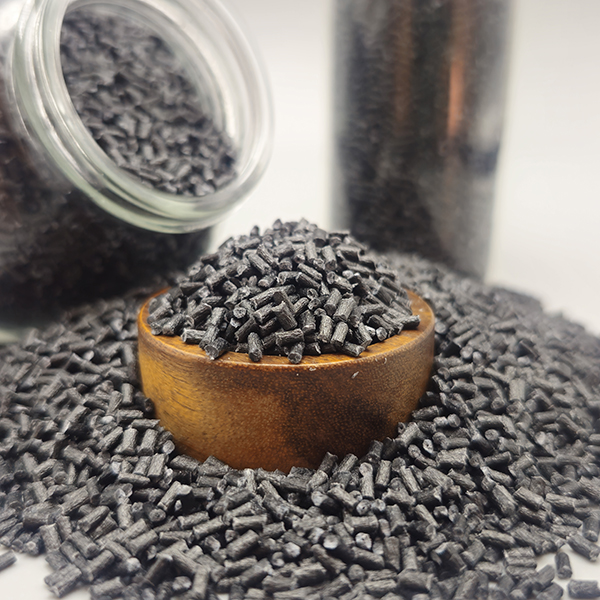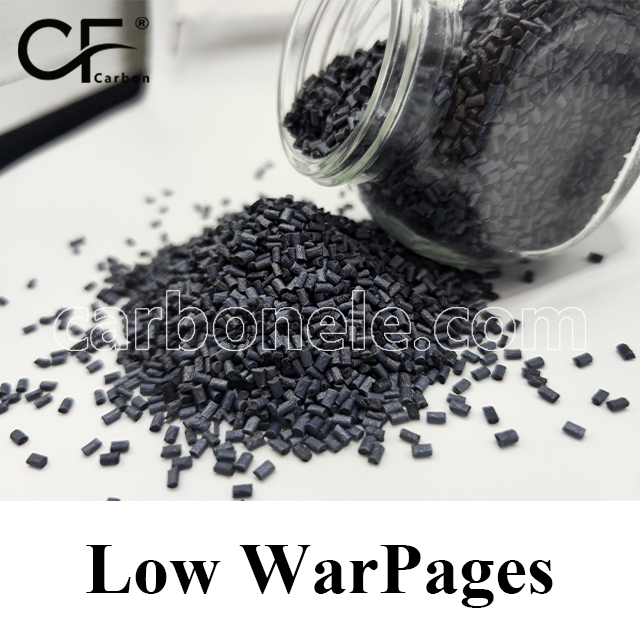
Thermoplastic ABS CF5 Composites for 3D Printing Filament
ABS CF5 refers to a specific type of filament used in 3D printing, combining ABS (Acrylonitrile Butadiene Styrene) plastic with approximately 5% carbon fiber by weight. Its filaments offer a balanced combination of strength, stiffness, and lightweight properties.
- Model: ABS-CF-BCA05
- Filler: Carbon Fiber
- Content: 5%
- Manufacturer: Yes
- OEM: Acceptable
- MOQ: 1000kgs
- Sample: Available
What’s ABS CF5?
ABS with 5% carbon fiber refers to a type of composite filament used in 3D printing. It is composed of ABS (Acrylonitrile Butadiene Styrene) plastic blended with approximately 5% carbon fiber material. Carbon fiber is a strong, lightweight material that, when combined with ABS, enhances the filament’s mechanical properties.
Here are some key characteristics of ABS carbon fiber 5% filament:
1. **Strength and Durability:** The addition of carbon fiber significantly improves the stiffness and strength of the filament. It makes printed parts more resistant to deformation and enhances their structural integrity.
2. **Lightweight:** Carbon fiber is known for its high strength-to-weight ratio, which means parts printed with ABS carbon fiber 5% filament can be lightweight yet robust.
3. **Surface Finish:** Prints made with ABS carbon fiber 5% filament typically have a matte black finish, which can be appealing for certain aesthetic or functional applications.
4. **Printing Considerations:** Due to the presence of carbon fiber, this filament may require specific printing settings compared to standard ABS. For example, higher nozzle temperatures and slower print speeds may be necessary to achieve optimal results and prevent nozzle wear.
5. **Applications:** ABS carbon fiber 5% filament is commonly used in applications where strength, durability, and stiffness are critical, such as functional prototypes, industrial parts, automotive components, and tooling.
Overall, ABS carbon fiber 5% filament offers a balance of mechanical strength, ease of printing (compared to pure carbon fiber filaments), and versatility, making it a popular choice among 3D printing enthusiasts and professionals for various applications.
Potential advancements and developments of ABS CF5
ABS CF5 offers enhanced mechanical properties over traditional ABS. Looking ahead, the future of ABS with 5% carbon fiber involves several potential advancements and developments:
1. **Improved Strength and Durability:** As research and development continue, there may be enhancements in the strength and durability of ABS carbon fiber composites. This could include optimizing the bonding between the ABS matrix and carbon fibers, resulting in stronger printed parts with reduced delamination issues.
2. **Broader Material Compatibility:** Manufacturers might explore blending ABS with other additives or fibers to further improve specific properties such as heat resistance, chemical resistance, or UV stability. This could expand the range of applications for ABS carbon fiber 5% filament.
3. **Advanced Printing Techniques:** Future advancements could focus on refining 3D printing techniques tailored for ABS carbon fiber composites. This might involve advancements in nozzle designs, temperature control systems, and software algorithms to optimize printing parameters for better part quality and reliability.
4. **Customized Filament Formulations:** There could be an increase in the availability of customized ABS carbon fiber filaments with varying percentages of carbon fiber content. Users may have the option to choose filaments with different strengths or stiffness levels depending on their specific application requirements.
5. **Industrial Adoption:** As industries continue to adopt 3D printing for manufacturing applications, ABS carbon fiber 5% filament could see increased adoption in sectors such as aerospace, automotive, and consumer goods. This would drive further research and investment into improving the material’s performance and scalability.
6. **Environmental Considerations:** Future developments might also focus on enhancing the sustainability of ABS carbon fiber composites, such as using recycled ABS or biodegradable additives without compromising mechanical properties.
Overall, the future of ABS with 5% carbon fiber filament looks promising with ongoing research and technological advancements aimed at enhancing performance, expanding applications, and improving the overall usability of these composite materials in 3D printing.
Content Block 1
Morbi iaculis at quam vel faucibus. Ut semper ipsum ex, quis aliquet justo pretium a. Suspendisse scelerisque metus augue, a interdum leo iaculis sed. Vivamus sit amet nunc odio. Duis vel pulvinar dolor, at lacinia tellus.
Pellentesque habitant morbi tristique senectus et netus et malesuada fames ac turpis egestas. Suspendisse lacinia quam a elit lobortis tempor


Content Block 1
Morbi iaculis at quam vel faucibus. Ut semper ipsum ex, quis aliquet justo pretium a. Suspendisse scelerisque metus augue, a interdum leo iaculis sed. Vivamus sit amet nunc odio. Duis vel pulvinar dolor, at lacinia tellus.
Pellentesque habitant morbi tristique senectus et netus et malesuada fames ac turpis egestas. Suspendisse lacinia quam a elit lobortis tempor

Frequently Asked Questions
Carbon (Xiamen) New Material Co., Ltd. aims to provide buyers with "one-stop" worry-free high-quality services. Here you can find all information about carbon fiber engineering plastics. If you still have questions, please send us an email for consultation!
-
How can I contact the manufacturer of a product that interests me?
When you find a product you are interested in, you can contact the manufacturer directly by sending an email and we will get back to you as soon as possible.
-
How do I find the products that interest me?
All you need to do is enter the keyword, product name in the search window and press the Enter key on your keyboard. Your search results page will then be displayed. You can also search within the product category pages on the home page. Each category is divided into subcategories, allowing you to refine your search and find products that interest you.
-
Where will I find a buying guide?
Please contact our after-sales service directly and we will provide you with a comprehensive operating guide.
-
What are CF Reinforced Thermoplastic Composites?
CF Reinforced Thermoplastic Composites are materials where carbon fibers are incorporated into a thermoplastic matrix. They combine the strength and stiffness of carbon fibers with the processability and recyclability of thermoplastics. For instance, they are used in automotive parts like bumper beams.
-
What are the benefits of CF Reinforced Thermoplastic Composites over traditional composites?
The key benefits include faster production cycles, easier recyclability, and better impact resistance. They also offer design flexibility. An example is in the manufacturing of consumer electronics casings where complex shapes can be achieved more easily.
-
How are CF Reinforced Thermoplastic Composites processed?
Common processing methods include injection molding, extrusion, and compression molding. Injection molding is widely used for mass production. For example, in the production of small components for the medical industry.
-
What industries use CF Reinforced Thermoplastic Composites?
They are utilized in aerospace, automotive, medical, and sports equipment industries. In aerospace, they can be found in interior components. In the medical field, they might be used in prosthetics.
-
How does the carbon fiber content affect the properties of the composites?
Higher carbon fiber content generally leads to increased strength and stiffness but may reduce ductility. A moderate content is often balanced for specific applications. For example, a higher content might be preferred in structural parts of a race car.
-
What are the challenges in using CF Reinforced Thermoplastic Composites?
Challenges include higher material costs, complex processing equipment requirements, and ensuring uniform fiber dispersion. Issues with adhesion between the fibers and the matrix can also arise. An example is in achieving consistent quality in large-scale production.

























